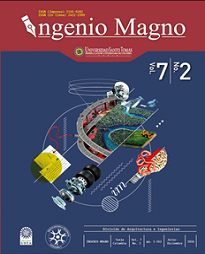Behavioral analysis of liquefaction due to sand flow in the quaternary deposit of paipa
Main Article Content
Abstract
Downloads
Article Details
DECLARATION OF ORGINIALITY OF SUBMITTED ARTICLE
With this document, I/We certify that the article submitted for possible publication in the institutional journal INGENIO MAGNO of the Research Center Alberto Magno CIIAM of the University Santo Tomás, Tunja campus, is entirely of my(our) own writing, and is a product of my(our) direct intellectual contribution to knowledge.
All data and references to completed publications are duly identified with their respective bibliographical entries and in the citations thus highlighted. If any adjustment or correction is needed, I(we) will contact the journal authorities in advance.
Due to that stated above, I(we) declare that the entirety of the submitted material is in accordance with applicable laws regarding intellectual and industrial property, and therefore, I(we) hold myself(ourselves) responsible for any complaint related to it.
If the submitted article is published, I(we) declare that I(we) fully relinquish publishing rights of the article to the University Santo Tomás, Tunja campus. As remuneration for this relinquishment of rights, I(we) declare my(our) agreement to receive two (2) copies of the edition of the journal in which my(our) article appears.
References
Asenjo, R. H. (2010). Resistencia cíclica en una arena de relaves (tesis de Ingeniería Civil). Santiago de Chile: Universidad de Chile.
Bishop, A. y Henkel, D. J. (1976). The measurement of soil properties in the triaxial test. Gran Bretaña: Edward Arnold.
Chu, J. y Leong, W. K. (2001) Pre-failure strain softening and pre-failure instability of sand: a comparative study. Geothecnique, 51, 311-321.
Georgiannou, V. N, Tsomokos, A. y Stavrou, K. (2008). Monotonic and cyclic behavior of sand under torsional loading. Geotechnique, 58, 113-124.
Gómez Vergara, E. J. (2010). Cambios de transformación de fase y atractores en materiales granulares (tesis de maestría en Ingeniería Civil). Bogotá: Universidad de los Andes.
Idriss, I. M y Boulanger, R. W. (2008). Soil liquefaction during earthquakes. Oakland: Instituto de Investigaciones de Ingeniería Sísmica.
Jiménez, O. J. (2011). Análisis del comportamiento de licuación por flujo en la arena del Guamo (tesis de maestría en Ingeniería). Bogotá: Universidad de los Andes.
Krammer, S. (1996). Geothecnical earthquake engineering. Washington: Prentice Hall.
Krumbei, W. C. y Sloss L. L. (1963). Stratigraphy and sedimentation. San Francisco: W. H. Freeman & Co. Murthy, T. G. (2007). Undrained monotonic response of clean and silty sands. Geotechnique, 57, 273-288.
Solaque, D. P. y Lizcano, A. (2008). Angulo de fricción crítico y ángulo de reposo en la arena del Guamo. Èpsilon, 11, 7-20.
Verdugo, R. e Ishihara, K. (1996). The steady state of sandy soils. Soils and Foundations, 36, 81-91.
Yang, J. y Dai, B.B (2011) Is the quasi-steady state a real behavior a micromechanical perspective. Géotechnique, 61, 175-183.

